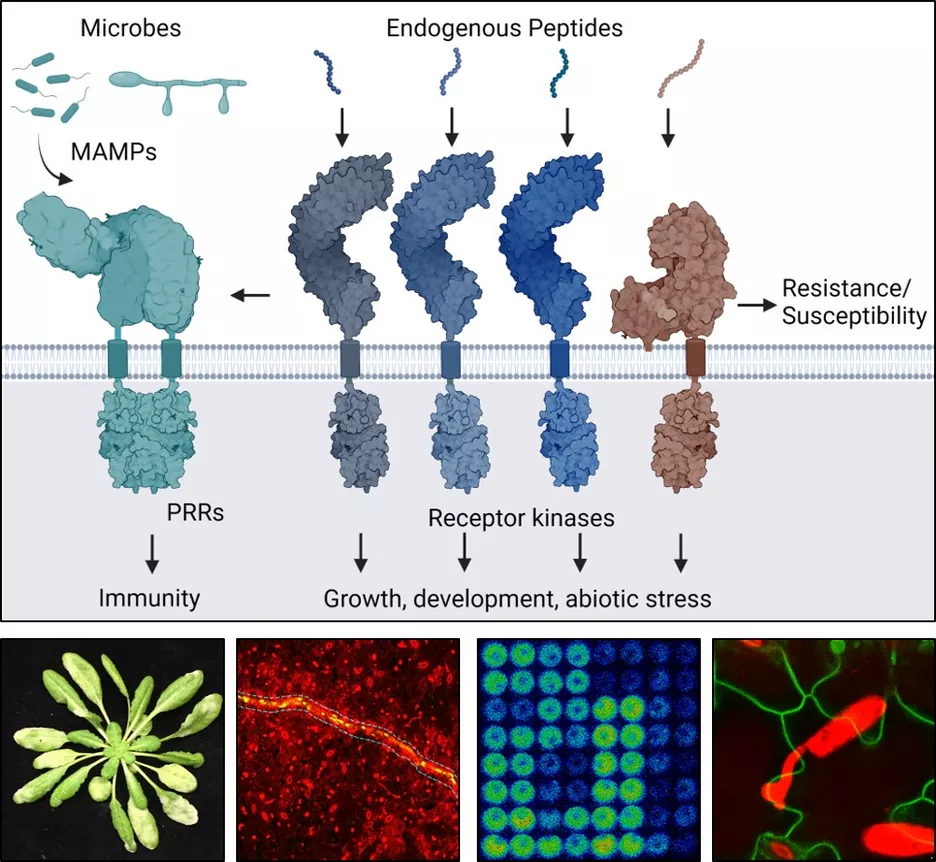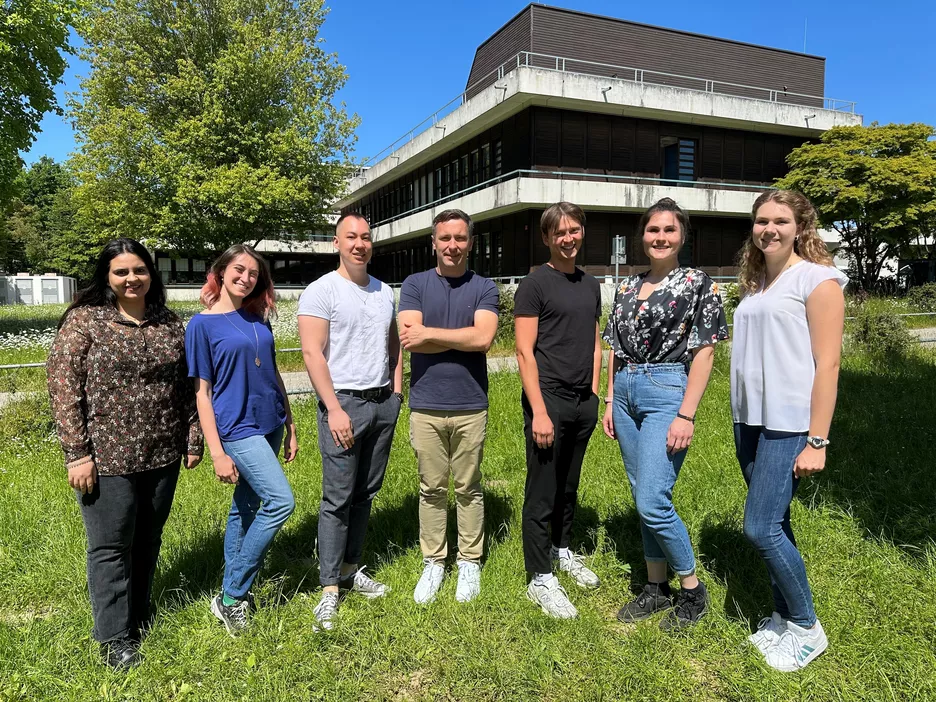Plant peptide signalling
Dr. Martin Stegmann
From April 1st of 2024, Dr. Martin Stegmann is Professor at University of Ulm while a part of his group continues working at the Chair of Phytopathology.
Control of pattern-triggered immunity, disease resistance and susceptibility by phytocytokines
Plants possess a sophisticated innate immune system consisting of different layers of constitutive and induced defence mechanisms. Pattern-triggered immunity (PTI) is the first line of induced resistance against microbes and initiated by the perception of highly conserved microbe- or pathogen derived molecular signatures (MAMPs/PAMPs) by plasma membrane pattern recognition receptors (PRRs), which are often receptor kinases (RKs). RKs also play crucial functions in perceiving cues involved in growth and development, including endogenous peptides. To increase complexity, there is emerging evidence that RKs primarily involved in growth and development, together with their ligands, can regulate immunity.
We are interested to identify growth regulatory peptides with an influence on PTI (phytocytokines) to study the mechanistic basis of signalling cross talk between different phytocytokine-mediated pathways. Furthermore, we are studying the influence of specific peptides on the interaction between the host plant and adapted powdery mildew fungi to close gaps in our understanding of the molecular mechanisms regulating disease susceptibility. We are performing a combination of genetic, biochemical, cell biological and plant phenotypic approaches using the model dicot species Arabidopsis thaliana (Arabidopsis).
The role of FERONIA during plant microbe interactions
In Arabidopsis, an important RK regulating both immunity and growth is the CATHARANTHUS ROSEUS RECEPTOR-LIKE KINASE 1-LIKE (CrRLK1L) FERONIA (FER), which perceives endogenous RAPID ALKALINISATION FACTOR (RALF) peptides and controls a multitude of processes, including pollen perception, cell elongation and root hair growth. Recent work has shown that FER serves as a RALF-regulated scaffold protein to facilitate the assembly of signalling-competent cell surface immune receptor complexes (Stegmann et al., Science 2017, Xiao, Stegmann, Han et al., Nature 2019). Despite serving as a crucial positive regulator of plant innate immunity, some adapted pathogens have evolved mechanisms to exploit the endogenous function of FER to cause disease. A major interest of our research is to study the molecular mechanisms governing the regulatory function of FER in growth, immunity and disease susceptibility.
Characterization of GLV and CEP phytocytokines
Other classes of signaling peptides are GOLVENs (GLVs) and C-TERMINALLY ENCODED PEPTIDEs (CEPs), both of which play important roles during root growth regulation and/or abiotic stress responses. GLV2 supports immune signaling in Arabidopsis via its ROOT MERISTEM GROWTH FACTOR INSENSITIVE (RGI) receptors. GLV2 stimulates immune receptor complex formation and promotes protein abundance of PRRs (Stegmann et al. 2022, EMBO Rep.). Our recent work suggests that CEPs activate immune responses and are perceived by three tissue-specific receptor kinases to mount antibacterial resistance. CEPs have a known function regulating nitrogen demand signaling and we have evidence that CEPs control a cross-talk between PTI and the plants nutritional status (Rzemieniewski et al., bioRxiv 2022). We are currently studying the mechanistic basis of GLV and CEP perception and their regulatory function in the cross talk between growth/development/abiotic stress and immunity.
Group members:
Jakub Rzemieniewski (doctoral student)
Henriette Leicher (doctoral student)
Sebastian Schade (doctoral student)
Sukhmanpreet Kaur (MSc student)
Zeynep Camgöz (MSc student)
Selected Publications:
Rzemieniewski J., Leicher H., Lee HK, Broyart C, Nayem S, Wiese C., Maroschek J, Camgöz Z., Olsson Lalun V, Djordjevic MA, Vlot AC, Hückelhoven R, Santiago J and Stegmann M. (2022). Phytocytokine signaling integrates cell surface immunity and nitrogen limitation. bioRxiv. doi:10.1101/2022.12.20.521212
Rzemieniewski J. and Stegmann M. (2022). SIRK1-QSK1 as a novel receptor complex perceiving endogenous PEP7 peptides. Mol. Plant 16:1–3.
Noble J.A., Bielski N.V., Liu M.-C.J., DeFalco T.A., Stegmann M., Nelson A.D.L., McNamara K., Sullivan B., Dinh K.K., Khuu N., Hancock S., Shiu S.-H., Zipfel C., Cheung A.Y., Beilstein M.A. and Palanivelu R. (2022). Evolutionary analysis of the LORELEI gene family in plants reveals regulatory subfunctionalization. Plant Physiol. 190:2539–2556.
Rzemieniewski, J. and Stegmann, M. (2022). Regulation of pattern-triggered immunity and growth by phytocytokines. Curr. Opin. Plant Biol. 68: 102230.
Stegmann, M.*, Zecua-Ramirez, P., Ludwig, C., Lee, H.-S., Peterson, B., Nimchuk, Z.L., Belkhadir, Y., and Hückelhoven, R. (2022). RGI-GOLVEN signalling promotes cell surface immune receptor abundance to regulate plant immunity. EMBO Rep. 23: e53281. *corresponding author
Xiao, Y.*, Stegmann, M.*, Han, Z.*, DeFalco, T., Parys, K., Xu, L., Belkhadir, Y., Zipfel, C.*, and Chai, J.* (2019). Mechanisms of RALF peptide perception by a heterotypic receptor complex. Nature 572: 270–274. *equal contribution
Stegmann, M.* (2018). EBP1: A crucial growth regulator downstream of receptor kinases across kingdoms. PLoS Biol 16(11): e3000056. *corresponding author.


Sukhmanpreet Kaur (MSc student), Zeynep Camgöz (MSc student), Sebastian Schade (doctoral candidate), Martin Stegmann (group leader), Jakub Rzemieniewski (doctoral candidate), Henriette Leicher (doctoral candidate), Luisa Huber (apprentice, technical assistant)